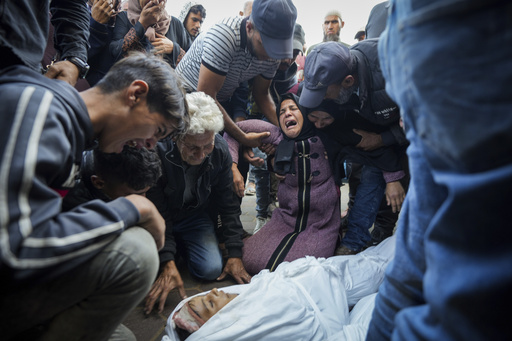
BEIRUT — As the Biden administration approaches its final months, the United States along with other mediators are intensifying their efforts to negotiate peace in the ongoing conflicts in Lebanon and the Gaza Strip. With negotiations having ground to a halt recently, the involved parties remain steadfast in their positions without any visible willingness to compromise.
On Thursday, senior White House officials Brett McGurk and Amos Hochstein are set to visit Israel to engage in discussions regarding potential cease-fires in both Lebanon and Gaza, as well as the release of hostages currently held by Hamas. This information comes from a U.S. official who spoke anonymously as they were not authorized to disclose this information publicly.
Proposals to quell the hostilities between Israel and Hezbollah include a two-month cease-fire during which Israeli forces would withdraw from Lebanon, while Hezbollah would halt its armed activities along the southern border, according to individuals familiar with the negotiations. However, skepticism remains, as Israel is reportedly hesitant to rely on U.N. peacekeepers and Lebanese troops to maintain a buffer zone in Lebanon, preferring the option to conduct strikes on militants as necessary, while Lebanese authorities seek a complete withdrawal of Israeli forces.
In a separate initiative, the U.S., Egypt, and Qatar have put forth a four-week cease-fire plan in Gaza that would entail Hamas releasing up to 10 hostages. Nonetheless, Hamas has shown reluctance to release numerous hostages without securing a long-term cease-fire and a full Israeli withdrawal from the area, even following the death of their key leader, Yahya Sinwar. Israeli Prime Minister Benjamin Netanyahu has asserted the need for continued Israeli oversight in parts of Gaza.
In Lebanon, there is an ongoing effort to revive U.N. Resolution 1701, which effectively ended the previous conflict between Israel and Hezbollah. Neither Hezbollah nor the Israeli government has publicly responded to the peace proposals aimed at halting the ongoing war, which has been escalating since mid-September of last year.
During a recent visit to Beirut, Hochstein held discussions with Nabih Berri, the Speaker of the Lebanese Parliament, where they outlined a framework for adhering to U.N. Security Council Resolution 1701. This resolution mandates a cease-fire between the two parties, the withdrawal of Israeli troops from Lebanese territory, and the presence of U.N. peacekeepers alongside the Lebanese army in southern regions.
There are reportedly divergent plans regarding a cease-fire in Lebanon, one of which suggests an immediate cessation of hostilities followed by a two-month period to fully enact the resolution. Following a cease-fire, it is envisioned that a 60-day span would begin, allowing the Lebanese military and U.N. peacekeeping forces to be deployed in the border area as both Israeli and Hezbollah fighters retreat.
The roadmap also contemplates increasing the U.N. peacekeeping forces from 10,000 to 15,000 personnel and elevating the number of Lebanese troops in the southern region from 4,000 to 15,000. Although Resolution 1701 also called for the disarmament of all armed groups, including Hezbollah, these stipulations are currently not part of the proposed implementation stages.
Israel has emphasized the necessity that any agreement incorporates assurances against Hezbollah’s rearmament and provisions allowing Israel to act within the buffer zone to address threats from the militant group. There remains uncertainty about whether Lebanon would consent to an arrangement that lets Israel maintain military actions on its territory, as Lebanese representatives continue to advocate for strict adherence to Resolution 1701’s requirements for Israeli withdrawal.
Hezbollah has declared that it will continue its rocket attacks against Israel unless there is also a cease-fire concerning Gaza. Uncertainties linger regarding whether this stance has shifted following the deaths of prominent Hezbollah leaders, including Hassan Nasrallah, in airstrikes conducted by Israel in the previous month.
Meanwhile, mediators are proposing a limited cease-fire within Gaza that would see eight to ten hostages released, as pointed out by a senior Egyptian official. Under this proposal, humanitarian support to Gaza would be increased, yet assurances for any future negotiations towards a lasting cease-fire are not guaranteed.
CIA Director Bill Burns is expected in Egypt shortly to further discuss these diplomatic efforts. Following the October 7 assault carried out by Hamas militants, which resulted in approximately 1,200 deaths and around 250 kidnappings, Israel has mounted a retaliatory offensive that, according to local health authorities, has claimed over 43,000 Palestinian lives, with many being civilians, including women and children.
Currently, it is estimated that around 100 hostages remain captive in Gaza, with about a third believed deceased. The most recent diplomatic initiative is inspired by Egyptian President Abdel Fattah el-Sissi’s proposition for a two-day cease-fire in exchange for the release of four hostages. Netanyahu has expressed a willingness to consider temporary truces aimed at facilitating hostage release, although he stated that he had not received a formal proposal based on Egypt’s recent initiative but would have accepted it.
Hamas has voiced openness to discussing alternative solutions but continues to uphold its prerequisites for a sustainable cease-fire, full Israeli withdrawal, and the liberation of Palestinian detainees. However, the mediators are conveying a sense of pessimism regarding the prospects for progress in these negotiations.
